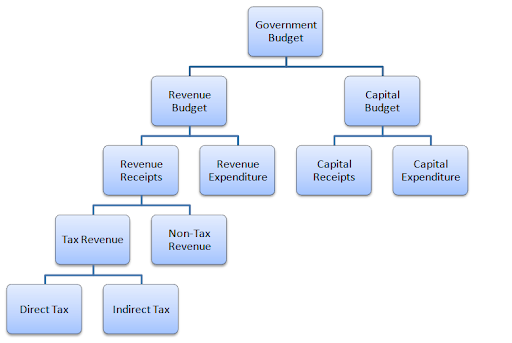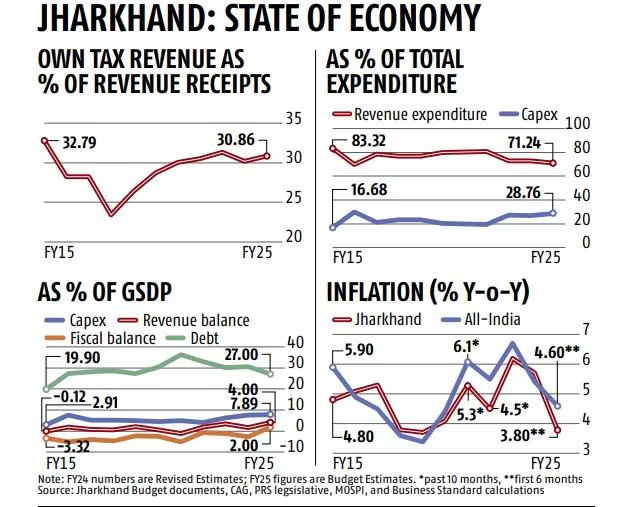Jharkhand Switch to Hindi
State’s Financial Landscape
Why in News?
Recently, the assembly election in Jharkhand has intensified, with both the ruling and opposition alliances launching economic initiatives aimed at garnering voter support.
Key Points
- Revenue Generation:
- Jharkhand generates only about 30.8% of its revenue receipts through its own tax collection, creating dependency on central government allocations.
- Pension Schemes:
- The state has expanded a universal pension scheme, reducing the age of eligibility from 60 to 50 for marginalized groups (Dalits, Adivasis, and women).
- The government supplements central pension funds, adding Rs. 240.4 crore to ensure that each recipient gets a monthly Rs. 1,000.
- Committed Expenditures:
- Salaries, pensions, and interest payments absorbed over one-third of Jharkhand’s revenue receipts in FY24, limiting fiscal flexibility for development projects.
- Capital Expenditure Focus:
- Jharkhand has prioritized capital expenditure, aiming to reach 7.89% of its GSDP in FY25, a substantial rise from 2.91% in FY15.
- The state’s capex-GSDP ratio is higher than many states, with a recent 7.57% in FY24, well above the national average of approximately 4.9%.
- Higher capex helps in creating assets that may boost long-term growth, despite current fiscal constraints.
- Fiscal Surplus and Debt Challenges
- Jharkhand has remained revenue-surplus for most years, except in FY15 and during the COVID-19 pandemic in FY21, maintaining a fiscal deficit of 2% (down from a high of 5.2% in FY21).
- Debt-to-GSDP Ratio:
- Jharkhand’s debt-to-GSDP ratio peaked at 36% in FY21 and remains high, projected at around 27% for FY25, though previous estimates have been revised upwards.
- The Reserve Bank of India ranked Jharkhand among the top 10 states with the highest debt-to-GSDP ratios, highlighting concerns over long-term debt sustainability.
- Economic Indicators and Social Challenges
- Unemployment: Jharkhand has a relatively low unemployment rate of 1.3% (2023-24), significantly below the national average of 3.2%.
- Poverty Levels: Jharkhand faces high multidimensional poverty, with 28% of residents experiencing deprivation, second only to Bihar (33.7%).
- Inflation:
- Overall Inflation: Declined to 3.8% in the first half of the financial year, below the national rate of 4.6%.
- Food Inflation: Rose to 8.9% in September, higher than the national 8.4%, while the average food inflation rate from April to September was 6.7%, still below the national trend.
- Conclusion: With the Jharkhand Assembly elections approaching, both the ruling coalition and opposition alliance are engaging in competitive social welfare and economic proposals to sway the electorate, amidst a backdrop of fiscal challenges, poverty, and inflationary pressures.
Uttarakhand Switch to Hindi
Uttarakhand’s CM Solar Self-Employment Scheme
Why in News?
Recently, the Uttarakhand government introduced a solar self-employment initiative aimed at promoting sustainable energy and rural employment opportunities.
Key Points
- Objective:
- Designed to curb migration by fostering local employment through solar power projects.
- Program Details:
- Individuals can establish solar plants (20–200 kW) and sell generated electricity to Uttarakhand Power Corporation Limited (UPCL).
- Financial support includes bank loans and assistance under the MSME and self-employment schemes.
- Economic Impact:
- Encourages income opportunities for local entrepreneurs, enhancing rural economies through sustainable practices.
Current Status of India’s Solar Sector
- About:
- India is the 3rd largest energy-consuming country in the world. India stands 5th in solar power capacity (REN21 Renewables 2024 Global Status Report).
- At COP26, India pledged to achieve 500 GW of non-fossil fuel-based energy by 2030, part of the Panchamrit initiative the world's largest renewable energy expansion plan.
- Solar Energy Growth:
- Installed solar energy capacity has increased 30-fold in the last 9 years, reaching 89.4 GW in August 2024.
- India’s solar potential is estimated to be 748 GWp (National Institute of Solar Energy, NISE).
- Investment and FDI:
- 100% Foreign Direct Investment (FDI) is allowed under the automatic route for renewable energy generation and distribution projects, subject to The Electricity Act, 2003.
Uttarakhand Switch to Hindi
Tent-Based Homestay Under Operation Sadbhavna
Why in News?
Recently, a tent-based homestay was inaugurated in Uttarakhand's Pithoragarh, aimed at promoting tourism and strengthening local community ties under Operation Sadbhavna.
Key Points
- Operation Sadbhavna:
- An initiative by the Indian Army focused on improving civil-military relations, fostering goodwill, and enhancing socio-economic conditions in border areas.
- Homestay Concept:
- Tent-based accommodations offer a unique experience to tourists, promoting eco-tourism in Pithoragarh, a strategic border district.
- Encourages local economic growth by involving community members in tourism-related employment.
- Significance:
- Strengthens cultural and economic engagement between the army and border communities, reinforcing security and mutual trust.
Operation Sadbhavana
- It’s an initiative of the Indian Army in Jammu and Kashmir and Ladakh to address the aspirations of people affected by terrorism.
- The operation is a part of the counter terrorist strategy to wrest the initiative and reintegrate the ‘Awaam’ with the national mainstream.
Madhya Pradesh Switch to Hindi
Rising Stubble Burning in Madhya Pradesh
Why in News?
Recent data reveals a surge in stubble burning in Madhya Pradesh, surpassing traditional hotspots Punjab and Haryana, intensifying pollution in Delhi.
Key Points
- Data Overview:
- Madhya Pradesh recorded 536 stubble burning cases recently, surpassing Punjab (410 cases) and Haryana (192 cases).
- Increased burning in Uttar Pradesh and Rajasthan also contributes to air quality issues, challenging previous assumptions about pollution sources.
- Impact on Delhi:
- Stubble burning has contributed significantly to Delhi's poor air quality, with projections suggesting an Air Quality Index (AQI) rise to 400 by 31st October, 2024.
- Urgent action is needed across states to manage crop residue burning, potentially through farmer incentives or alternative uses.
Stubble Burning
- About:
- Stubble (parali) burning is a method of removing paddy crop residues from the field to sow wheat from the last week of September to November, coinciding with the withdrawal of southwest monsoon.
- Stubble burning is a process of setting on fire the straw stubble, left after the harvesting of grains, like paddy, wheat, etc. It is usually required in areas that use the combined harvesting method which leaves crop residue behind.
- It is a common practice in October and November across North West India, but primarily in Punjab, Haryana, and Uttar Pradesh.




%20MPPCS%202025%20Desktop%20E.jpg)
%20MPPCS%202025%20Mobile%20E%20(1).jpg)










.png)
.png)











 PCS Parikshan
PCS Parikshan



